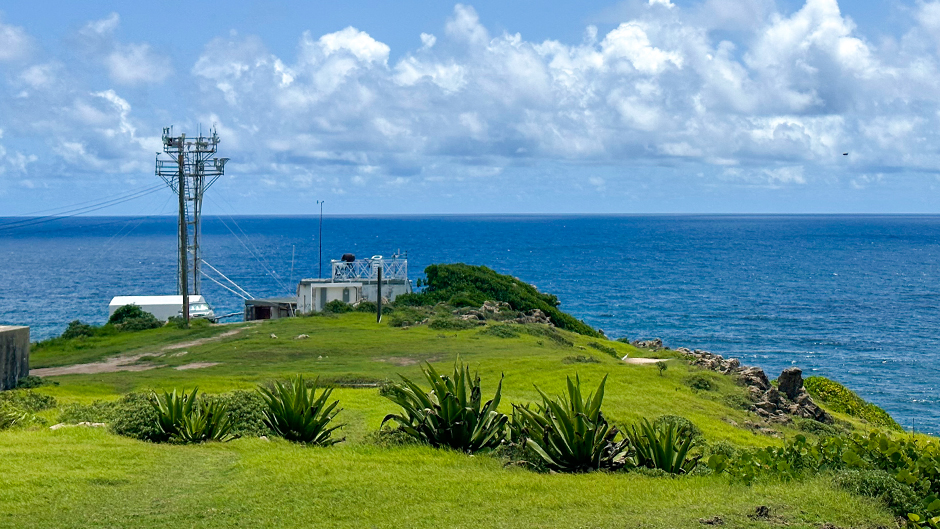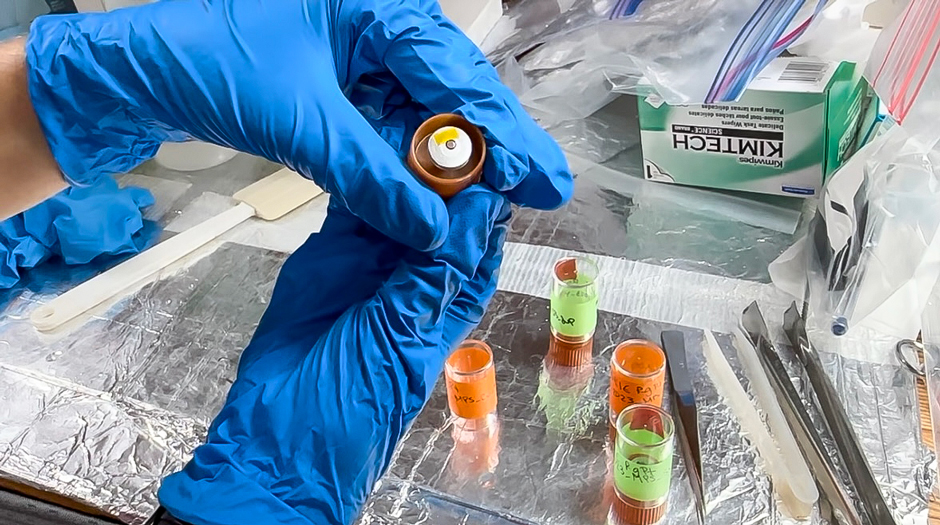Joseph Prospero scaled the 55-foot tower at Ragged Point so many times during his decades-long stint overseeing a specialized University of Miami laboratory on the east coast of Barbados that he lost count. Two hundred. Perhaps three hundred—he isn't quite sure.
But what the emeritus professor of atmospheric sciences does know is that each ascent was essential. Sometimes, it was to change one of the filters that captured samples of Saharan dust that traveled the expanse of the Atlantic Ocean. Other times it was to install new equipment or to repair gadgetry that had malfunctioned.
Now, that tower—the signature attribute of the University of Miami's Barbados Atmospheric Chemistry Observatory (BACO)—will soon be disassembled, making way for a new one.
Its removal, scheduled to take place sometime in January, will be the crowning moment of a million-dollar upgrade to a facility that for nearly 60 years has documented the transport of African dust to the Caribbean Basin, allowing scientists to study its impact on climate, clouds, and air quality.
"It's really a rebirth," said Cassandra Gaston, the associate professor of atmospheric sciences at the Rosenstiel School of Marine, Atmospheric, and Earth Science who has taken up the torch of overseeing the site, carrying on the work started by Prospero when he founded BACO in 1966. "The site's held up well over the years. But the infrastructure is in a salty environment and needs to be replaced," she added.
The tower is just one of BACO's many important components. Located on a promontory on the easternmost point of Barbados, the site also includes two shipping containers converted into high-tab labs that contain the instruments scientists use to analyze samples collected from the pillar.

New instruments were integrated at the site over the summer—among them, scientific tools that allow Gaston and others to study the size distribution of aerosol particles and to test for the presence of trace metals in the air above Barbados. The latter could help provide the answers to a puzzle the country's health officials have been trying to solve for years: why cases of pediatric asthma on the island are so high.
"We've never measured for trace metals before. But that's a different story with the new instruments we've acquired. We can now look at, for example, components that fertilize the North Atlantic Ocean, such as iron, which is a key nutrient for marine phytoplankton; and phosphorus, which is vital for plant growth in the Amazon," Gaston explained.
"And then, we can also look at more harmful elements that are coming mainly from manmade emissions and look at how many of those types of emissions are being transported," she added. "We don't know as much about those as we should. Is there a connection between the high incidence of pediatric asthma and those harmful elements?" she continued. "Barbados isn't upwind of anything. It's the easternmost island in the Lesser Antilles, so it basically just gets a lot of sea spray and whatever is being transported in the air as the result of industry or biomass burning from Africa. The hope is to be able to provide some metrics to establish a link, if there is one."
And that is where research conducted by College of Engineering Dean Pratim Biswas comes in. A pioneer in the field of applying aerosol science and engineering to other areas such as health and medicine, he plans to travel to Barbados in January to iron out the details of a research project in which some residents will don wearable sensors—miniaturized versions of the monitoring instruments at the BACO site—to record particulate matter.
"The sensors can be easily clipped to someone's shirt, always staying with an individual, whether they're walking around, participating in physical activities, or even sleeping. If they're in an area that's polluted, we'll be able to track it," said Biswas, who is part of Gaston's National Science Foundation Major Research Instrumentation grant that made the BACO upgrades possible. He added that the site will directly impact research that will be conducted at the new University of Miami Center for Aerosol Science and Technology.
Other new instruments recently installed at BACO are also now in full use, helping researchers take measurements of the exchange processes of heat, moisture, African dust, and sea spray between the atmosphere and ocean over the Subtropical Atlantic. Those measurements are part of the yearlong MAGPIE—or Moisture and Aerosol Gradients/Physics of Inversion Evolution field experiment, which Gaston and her team are helping to lead in collaboration with the Naval Research Lab, the National Oceanic and Atmospheric Administration, the Caribbean Institute for Meteorology and Hydrology, and other institutions.

Such collaborations have inspired other scientific groups to conduct research on the island that complements that of BACO. Twelve years ago, the Max Planck Institute for Meteorology in Hamburg, Germany, established the Barbados Cloud Observatory on a bluff just south of the site. Still, it is BACO that started it all. "Cassie is revitalizing a long-standing dust record—the longest dust record I am aware of in the Western Tropical Atlantic. It is essentially a climate data record, and that in itself is important," said Paquita Zuidema, professor and chair of the Department of Atmospheric Sciences, who helped write the grant for the BACO upgrades.
Zuidema, whose research focuses on the relationship of warm, shallow clouds to the large-scale environment, with an emphasis on the connection to radiation, said she intends to find new ways to extend Gaston's measurements to cloud interactions.
Prospero hopes to make it back to Barbados for the occasion when the old tower he climbed countless times is retired. When he founded BACO nearly 60 years ago, few scientists were interested in the long-range transport of aerosols.
"The initial work we did in Barbados, which in effect described the fundamentals of the African dust transport phenomenon, was all done without any money—it was all bootleg work," Prospero recalled. "But over the years, that interest has increased, and now the climate community is fully aware of the importance of aerosols and the role they play in climate."
BACO's location makes it ideal for the study of aerosol transport. "It's right in the heart of the trade wind machine, so it's in the bullseye of African dust transport," Prospero said. "And there's nothing upwind of its location. So, what they're getting in Barbados is the composition of air without any local or regional sources inputting anything into our sampler. Here in Miami, we sample African dust as well, but it's mixed in with a lot of other pollutants that come from some of the islands or from a front from the Northeast comes through. So, that does not give us an unbiased measure of African dust property concentrations over the Tropical Atlantic."
While BACO has helped to demystify many aspects of African dust transport, unanswered questions remain, such as the driving forces behind dust outbreaks and the reasons for their considerable year-to-year variability, Prospero pointed out. Also of concern: why concentrations of nitrate and sulfate have spiked recently in the Barbados atmosphere. Through research and more sampling, those are questions Prospero and Gaston hope to answer.
"The work continues," he said.






